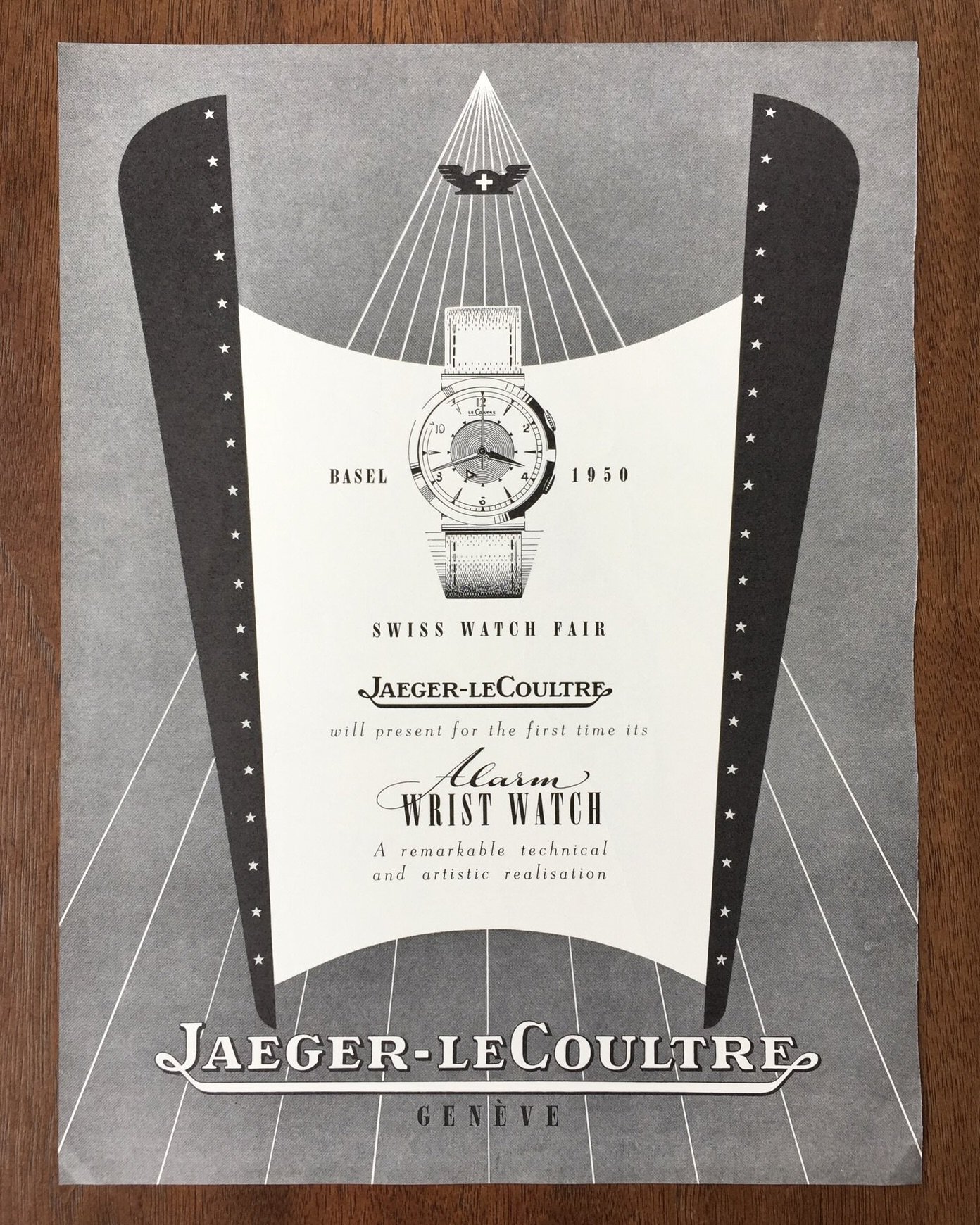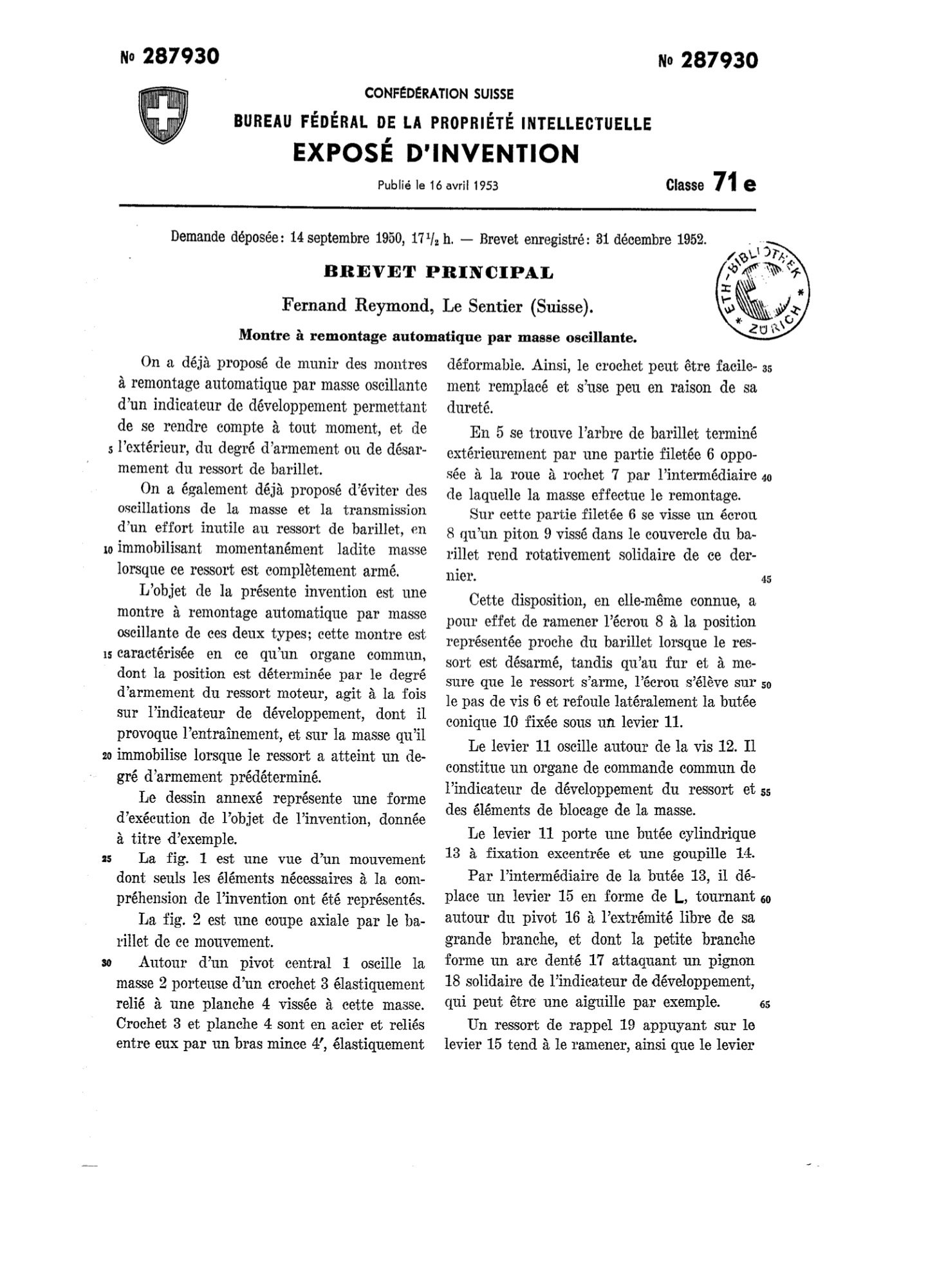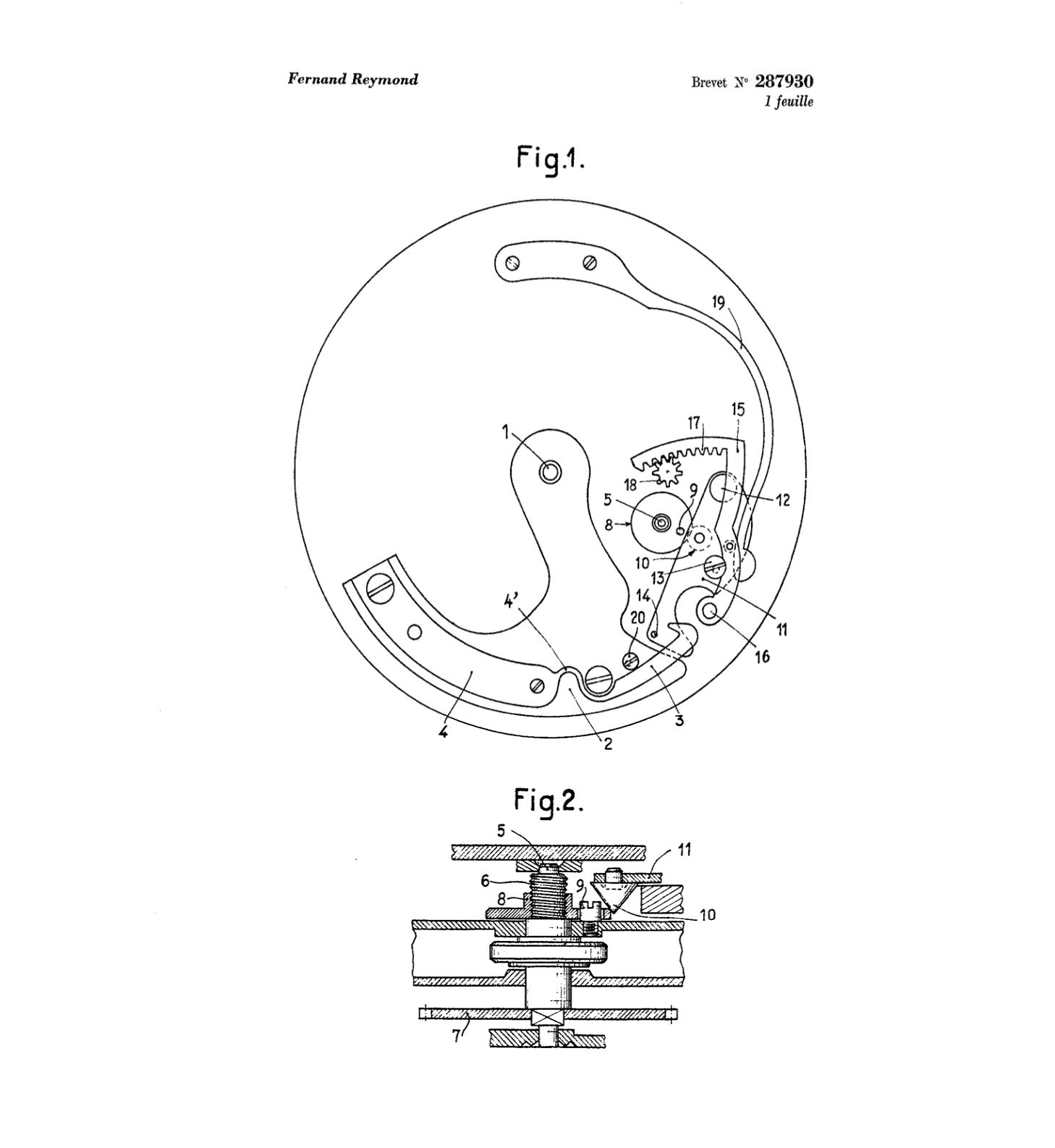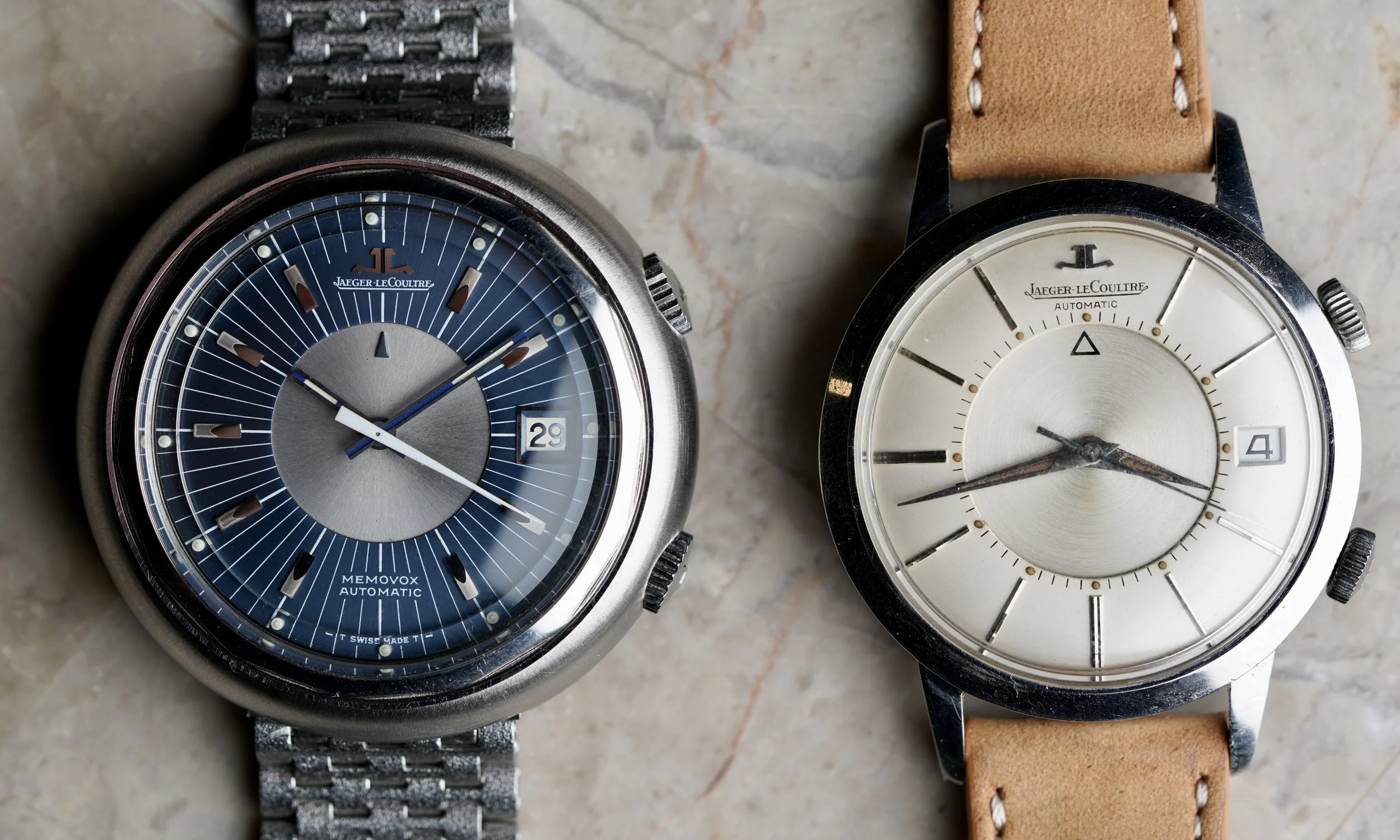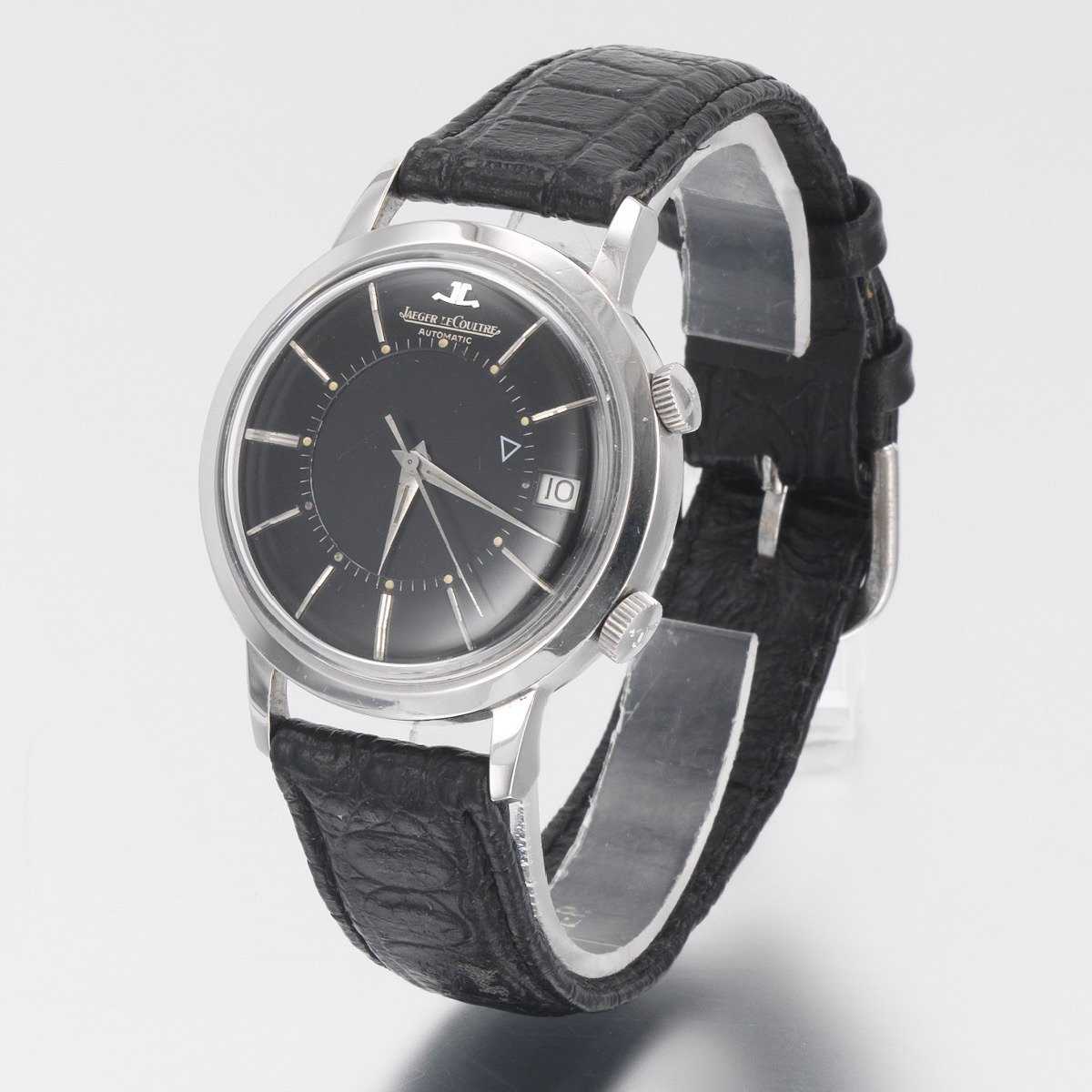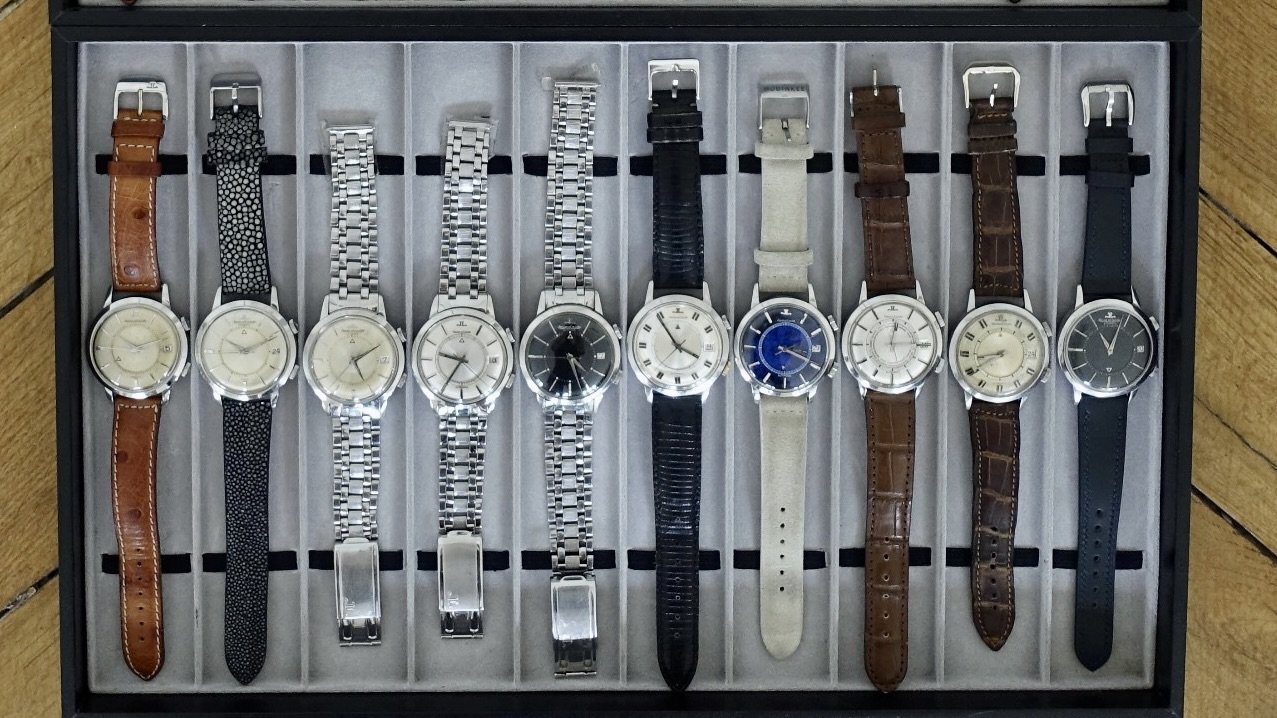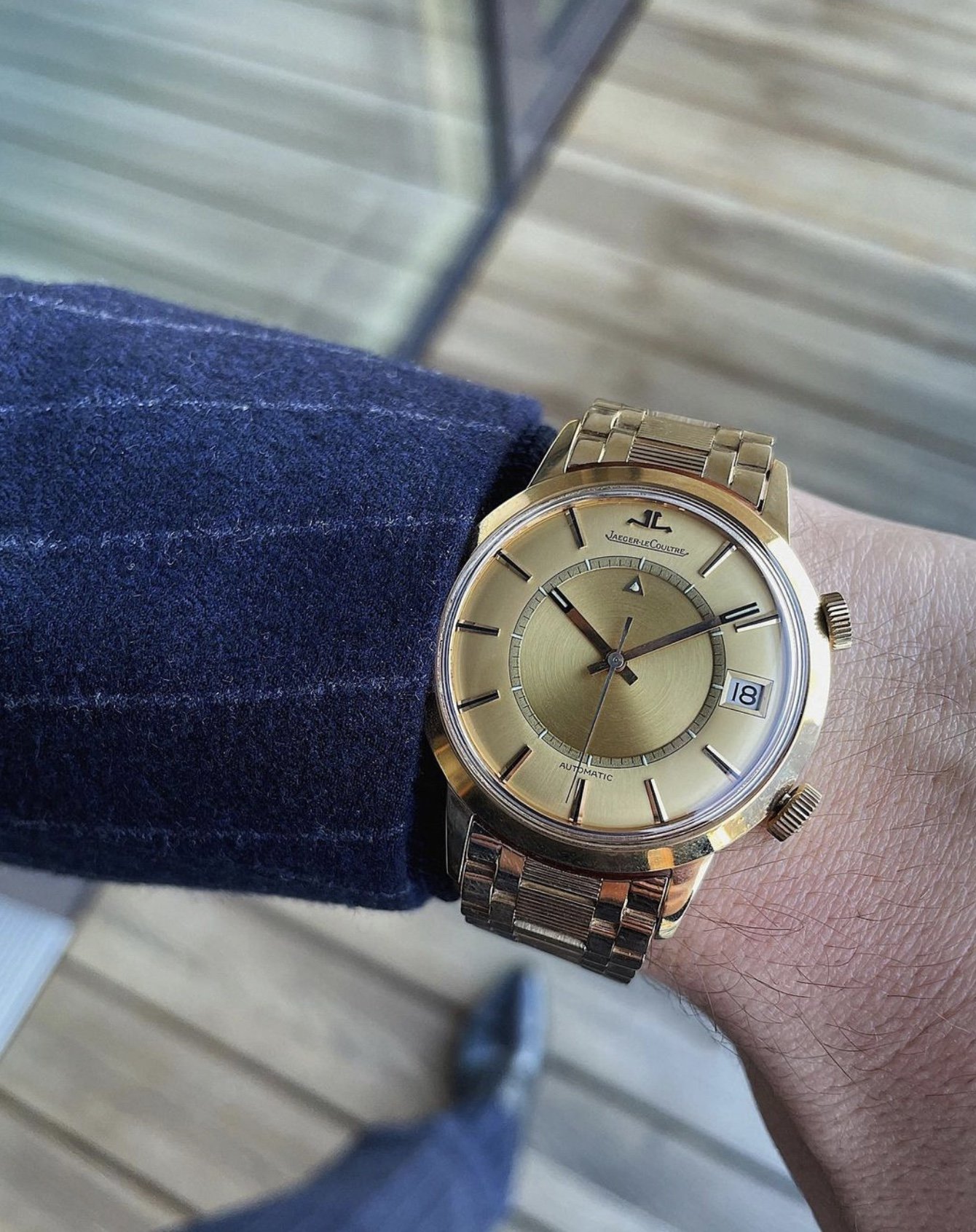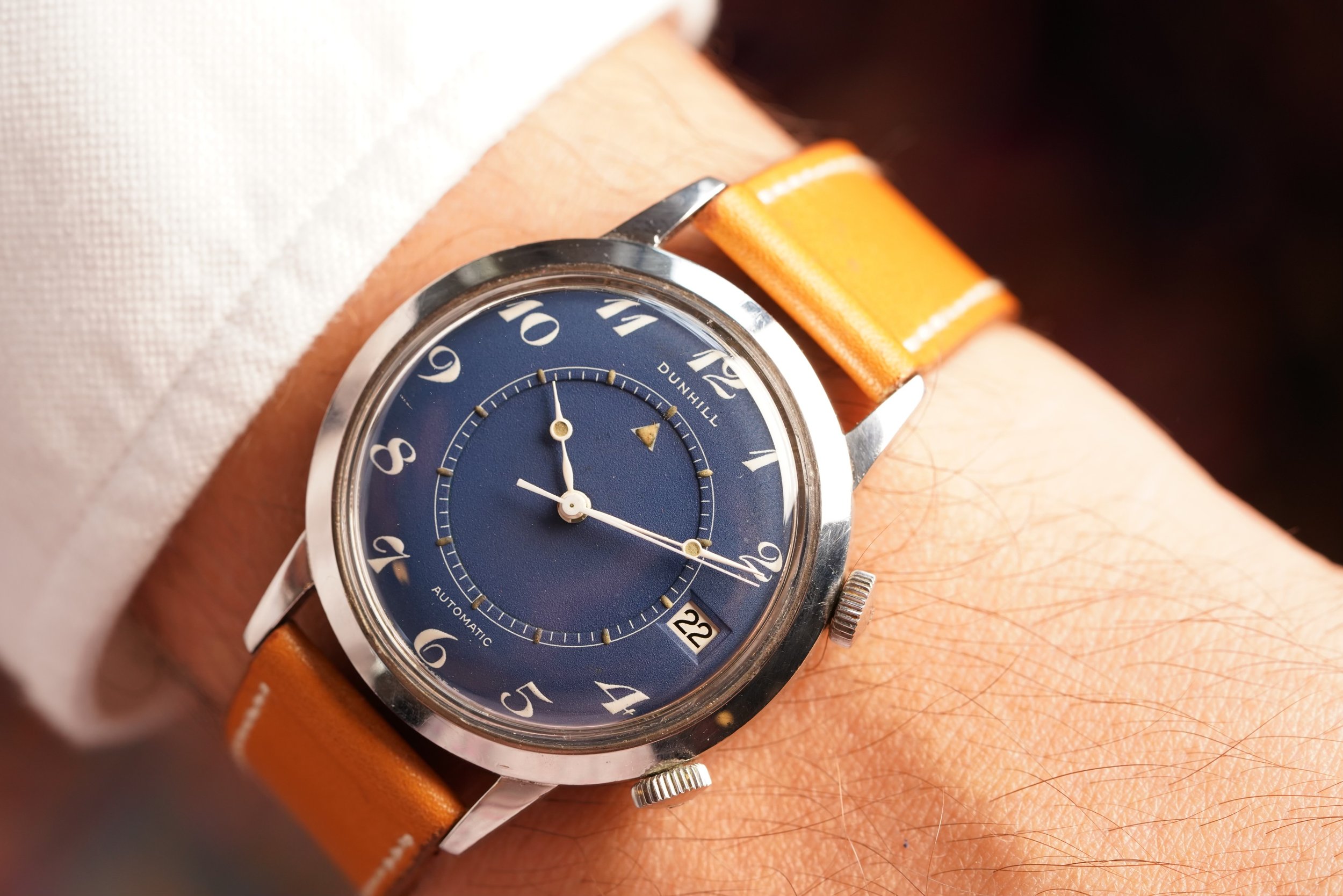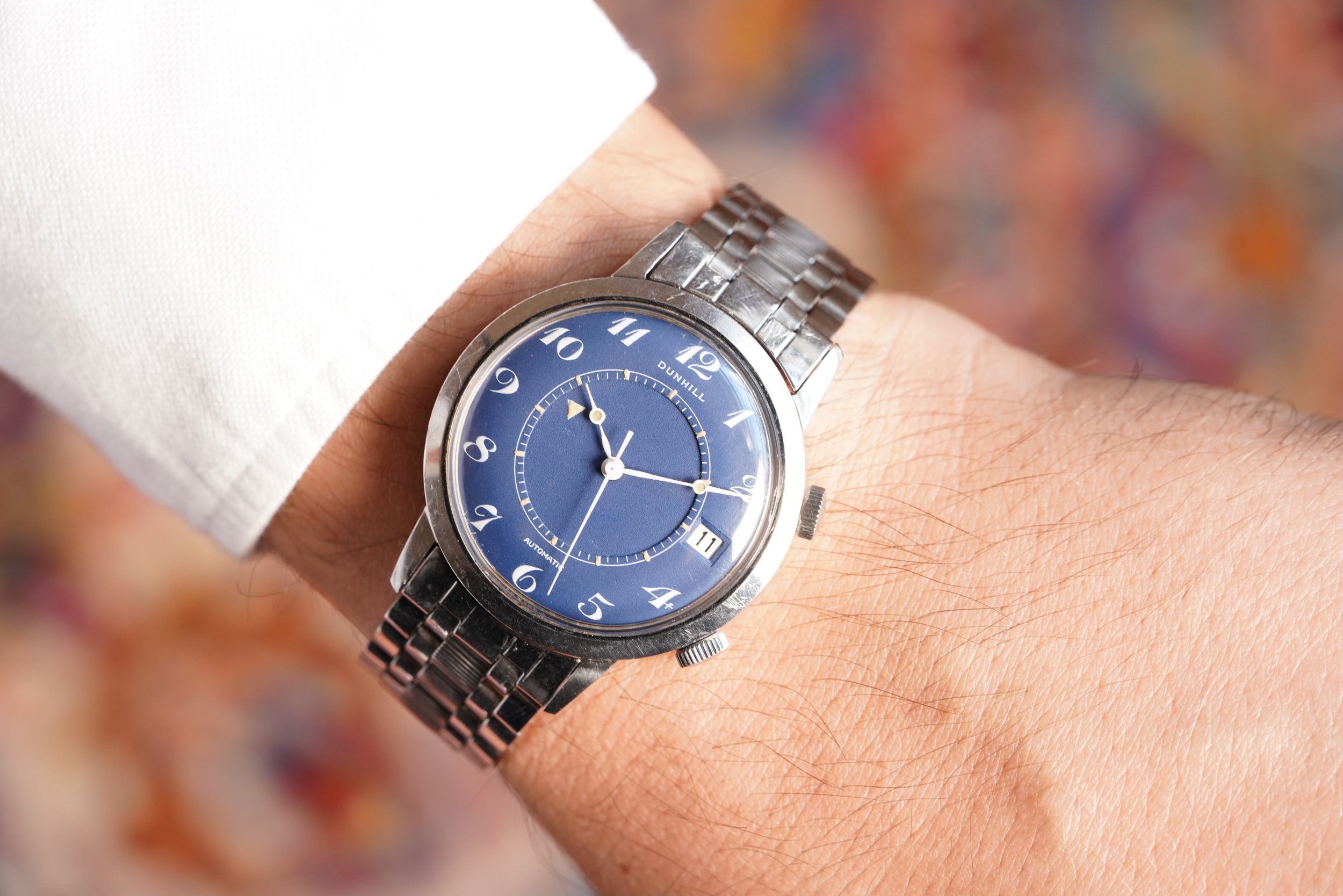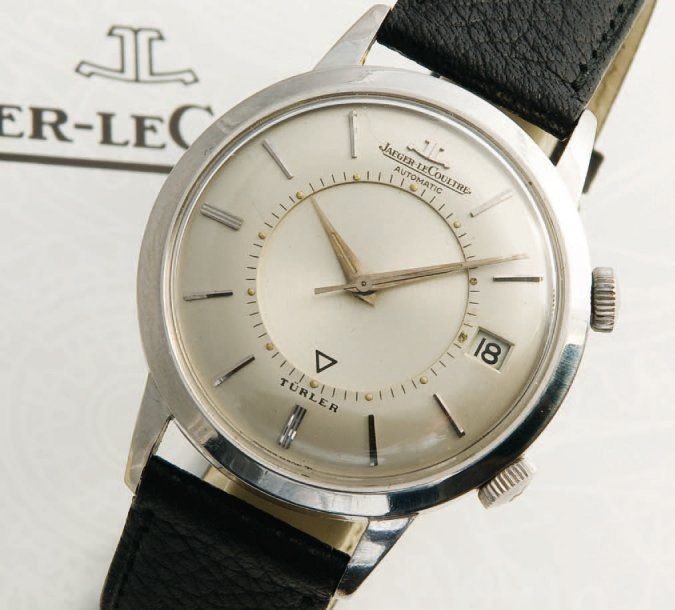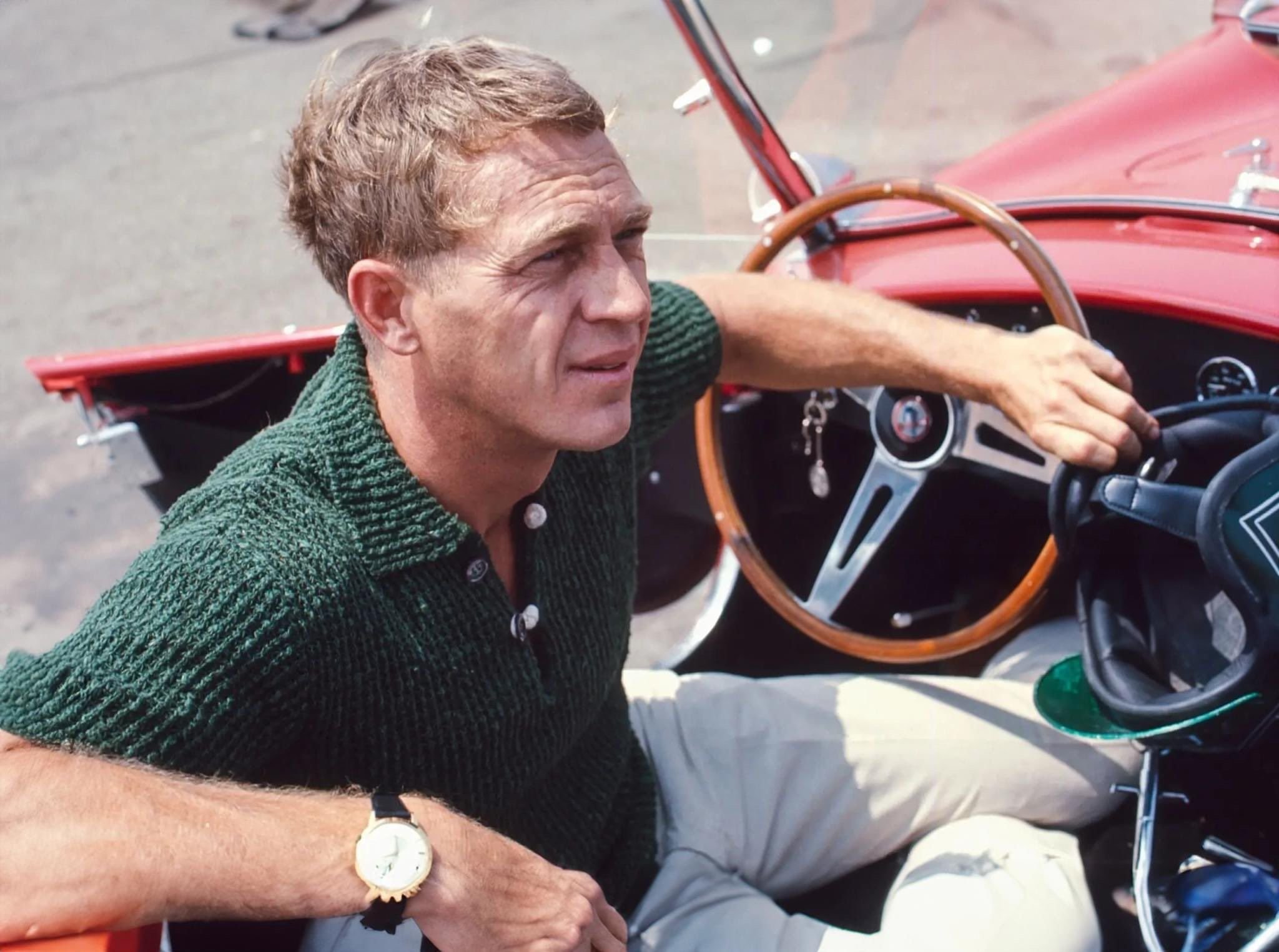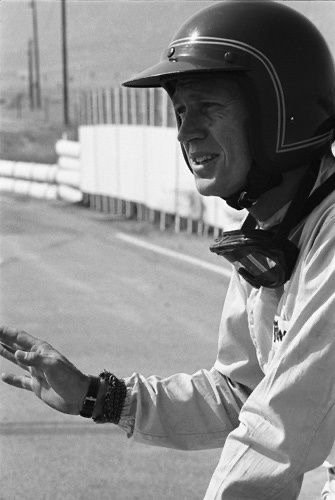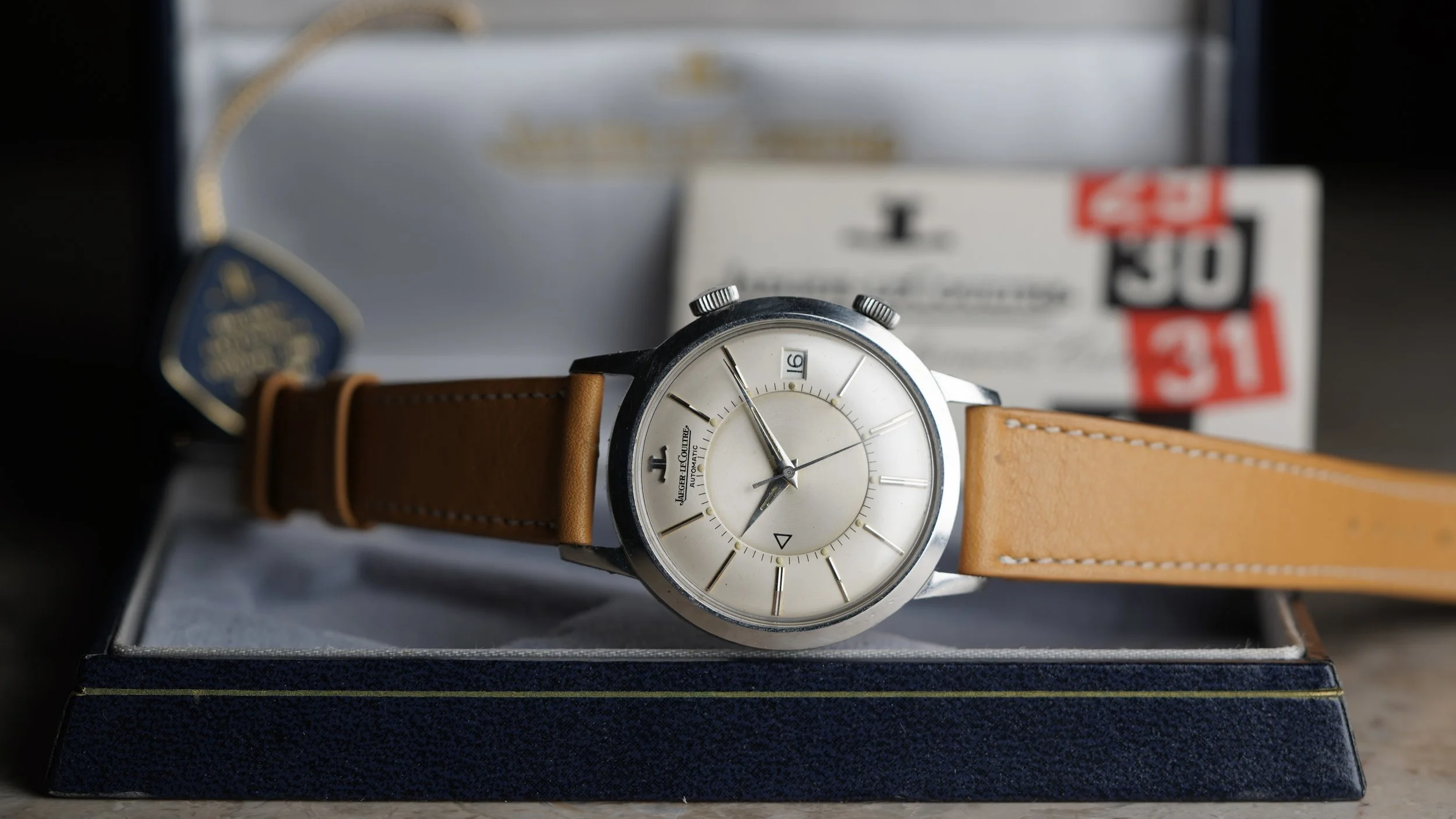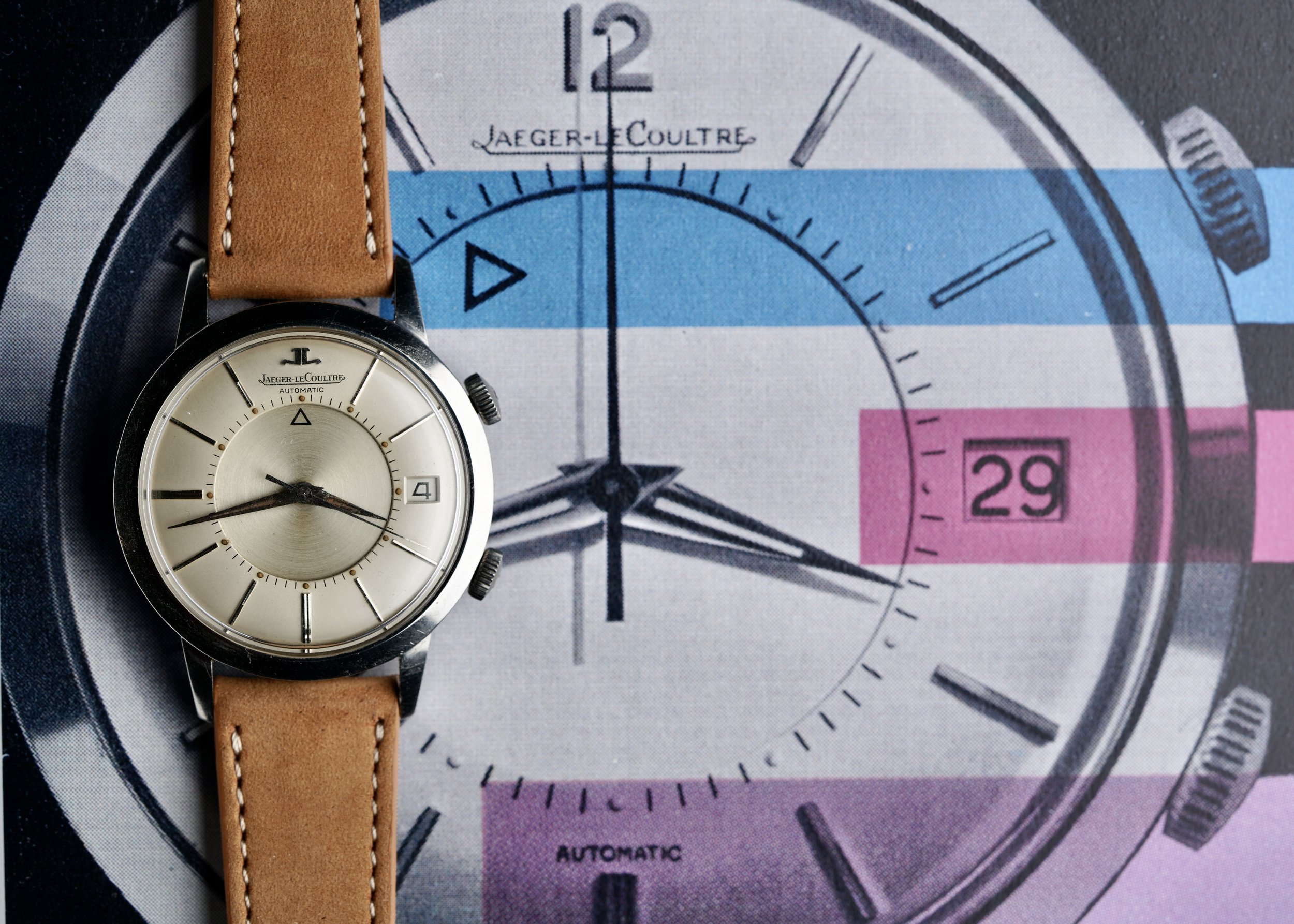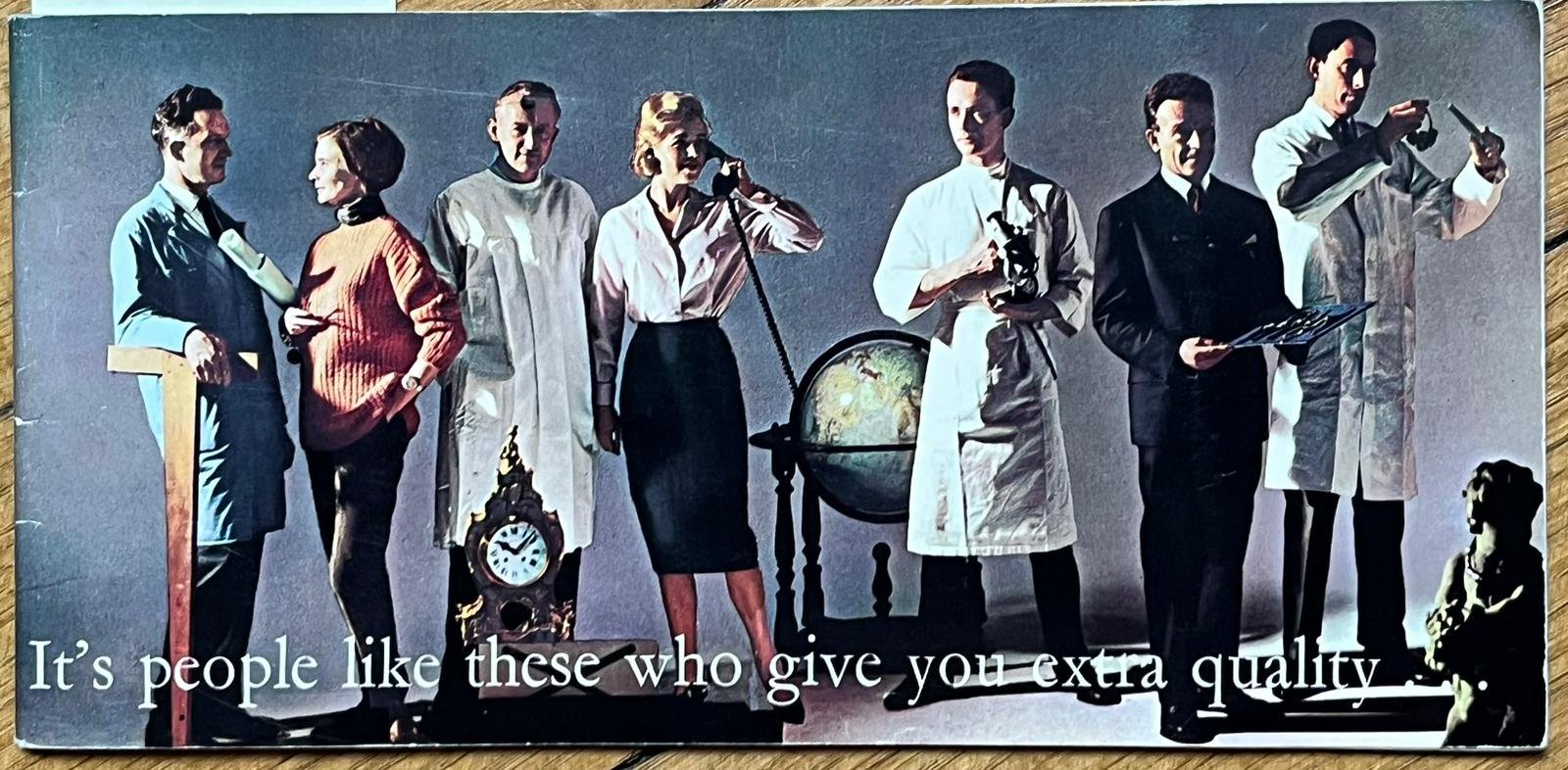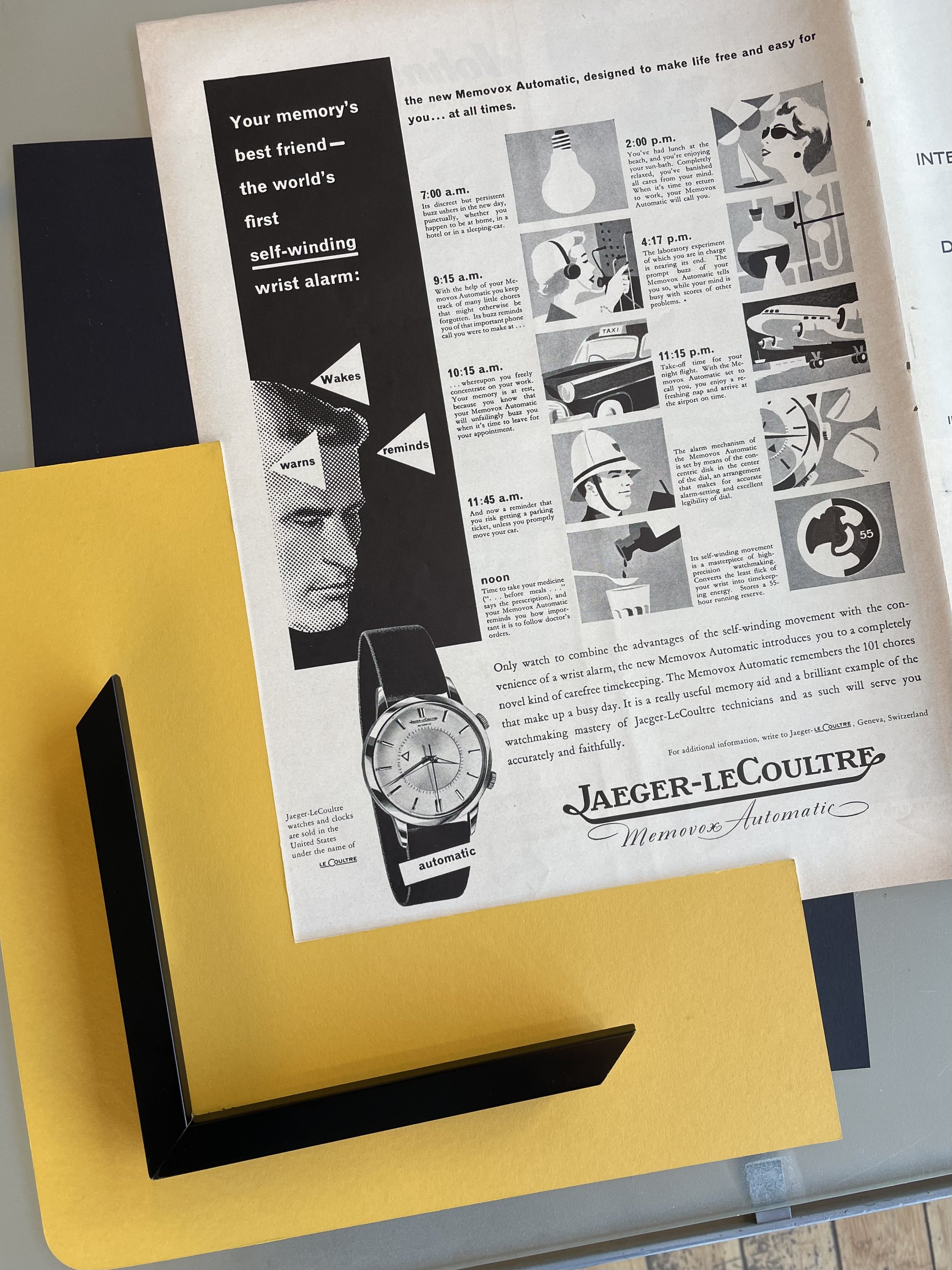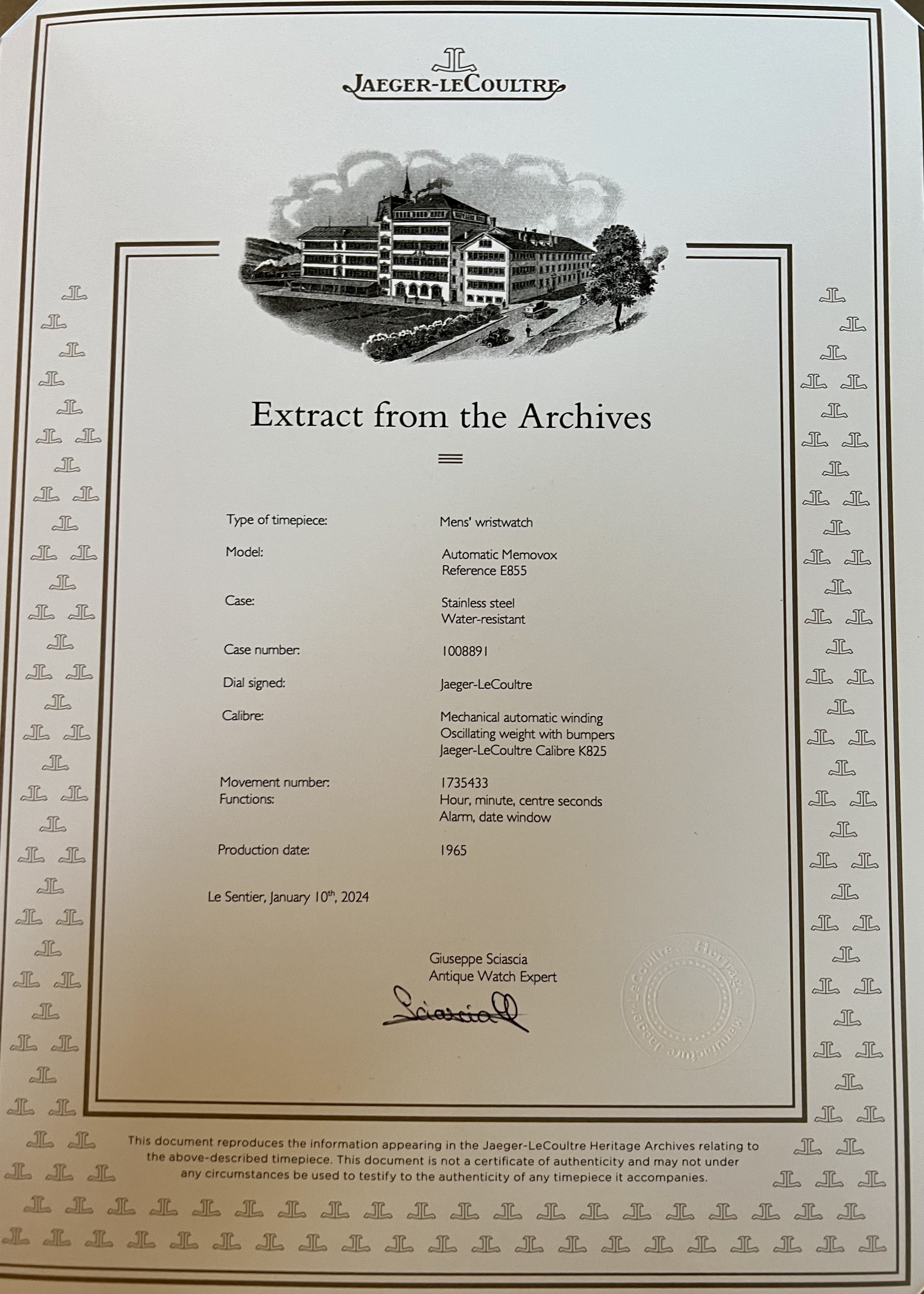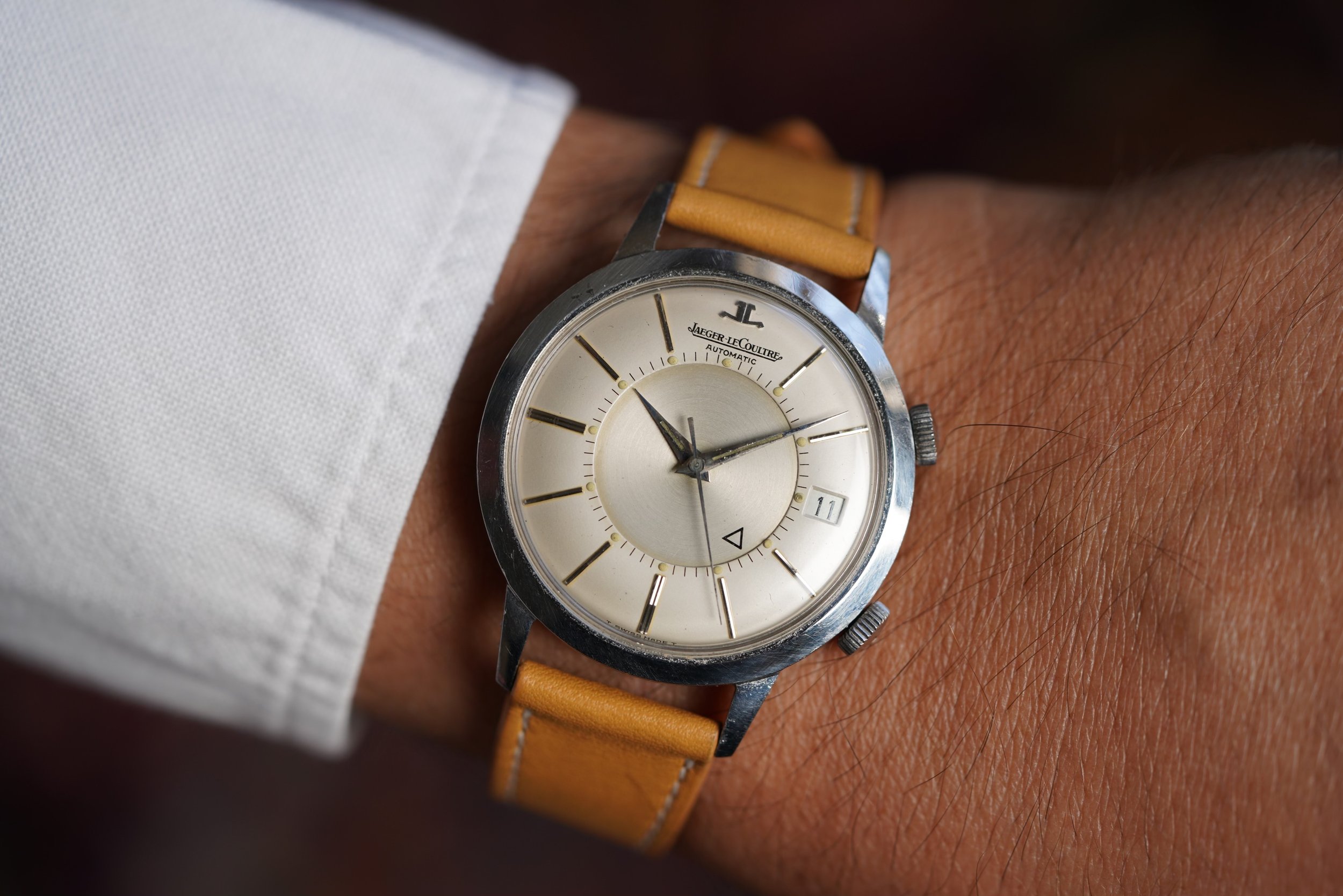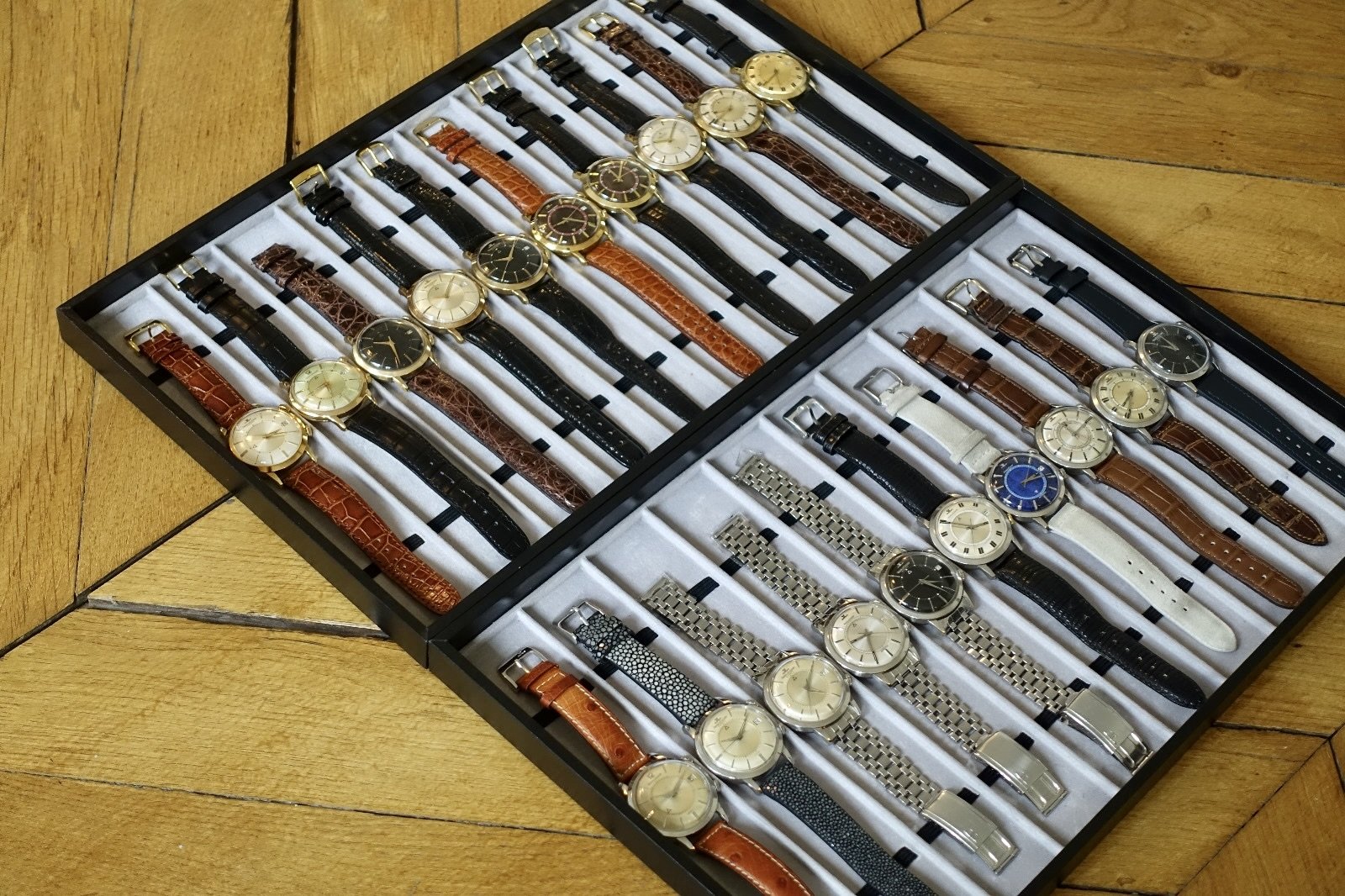Collector's Guide: Jaeger-LeCoultre Memovox Reference E 855
By Charlie Dunne
There are a number of watch models and references that will forever be meaningful to me. Models such as the Rolex GMT-Master reference 1675, Vulcain Cricket, Rolex Submariner reference 5512, and the Rolex Oyster Perpetual reference 1018 are a few that feel very personal. It almost always derives from obsession and then eventual ownership - so here’s to my future black-dial Rolex Milgauss reference 1019! I recall purchasing my first vintage watch - a Jaeger-LeCoultre Memovox reference E 855. I had a great feeling that I had the smartest watch on the scene. An unassuming alarm watch with dual crowns. I didn't understand the condition of what I was buying, and it didn’t necessarily matter to me at the time. It was a vintage Jaeger-LeCoultre!
JLC in many ways to me is among the greatest manufacturers of all time. People often cite the “Holy Trinity” of watchmaking. In my perspective, manufacturers such as Rolex, Longines, and Jaeger-LeCoultre are amongst the highest rank for their amazing heritage, designs, near vertical integration, production, and contributions within the story of watchmaking. I am convinced there has been a Vacheron PSYOP occurring over the past two decades. Few manufacturers can claim their role as a patron to the Swiss watchmaking industry to the degree Jaeger-LeCoultre could. Yet the manufacturer is far too sophisticated and deferential to boast. It is a connoisseur’s watch.
“I think you can do better” was Eric’s response when I asked him to share his thoughts on my Memovox. Looking back, it was a tragic and shameful sight - over polished and in terrible condition. I deleted the IG posts, but you never truly forget. It was at this time I decided to sell my first Memovox E 855 and a few other watches to focus more on condition. The watches I collected were not E 855s, yet very respectable examples. Although I continually searched for a great E 855 to one day add back into my collection.
The Memovox is one of the many watches that deserves recognition in the vintage watch collecting scene, and not entirely due its association with the alarm complication. From a design perspective, many gravitate toward the dual-crowned watch only to then learn about the timepiece’s vocal tendencies. Of course, others became aware of the watch after its appearance on television shows like ‘Mad Men’. Attracting the attention of both collectors and noteworthy performers, the Memovox has been worn by the likes of Miles Davis, Charlie Chaplin, Robert De Niro, Tony Bennet, Stirling Moss, and even Steve McQueen.
1950 Basel Fair ad of Jaeger-LeCoultre reference 3150 Memovox with hooded lugs. Image credit: Ad Patina
Introduced at the Swiss Watch Fair at Basel in 1950, Jaeger-LeCoultre’s alarm wristwatch has enjoyed decades of continual production and a diverse catalog that can be looked back upon with fondness. As for the lines’ impact upon the manufacturer, the Memovox is an integral part of JLC’s legacy alongside such timepieces as the Reverso and Atmos clock. Of the dozens of iterations, it is the models from the late 1950s and 1960s that I find most exciting to collect and wear.
A variety of JLC Memovox models from the 1950s-1960s. From left to right: Memovox reference E 855, Memovox reference E 853 in 18k yellow gold, Memovox reference 3151, another Memovox reference E 855.
Speaking with vintage Jaeger-LeCoultre collector and expert @Fldx_Clavi, he would point out a very interesting anecdote of the Memovox’s steadfast production:
“While the Reverso is often viewed as the emblematic Jaeger-LeCoultre model nowadays, for collectors, the Memovox occupies a very special place as it is the witness of the continuous evolution of the manufacture across decades. In fact, the Memovox is still to date the longest lasting model series for Jaeger-LeCoultre, with continuous production in one form or another since 1950 ie ~75 years uninterrupted catalog time.
In comparison, the Reverso was originally produced for about a decade in the 1930s, and was back into regular production after a 35-40 years 'pause' to become the flagship it is today.
The longevity and the variety of the Memovox line is what makes it captivating. To my knowledge, it is one of the longest watch lines in history, coming 2nd only after the OMEGA Seamaster which was introduced in circa 1948. So this is only 2 years before and (possibly) uninterrupted since!”
In 1960, the Memovox reference E 855 was introduced. According to The Collectibles, the model would remain in production until circa 1974. The Jaeger-LeCoultre reference E 855 is a very special and groundbreaking model. It was a calendar iteration of the automatic-alarm calibre 815. The E 855 was introduced approximately three years after the first automatic Memovox - the no-date Memovox reference E 853. Both of these watches are distinguished by their relatively large dimensions, as well as their reliable and innovative movements.
For those a bit more familiar with Rolex, @Fldx_Clavi would make the analogy “In a way, the E855 is the ‘date’ version of the E853 like the Submariner reference 1680 is the ‘date’ version of the reference 5512. It’s actually even closer as the two Memovox models share the same case, with even some cases stamped E853-855 during the short time period when both were sold!”
Calibre 825
The calibre 825 is a highly important movement, both for Jaeger-LeCoultre and for alarm watches as a whole. The calibre 825 was introduced in 1959 and would be produced by JLC until 1969 with approximately 67,000 units. The following year (1960), the reference E 855 would become the first automatic alarm watch with a calendar function. Mind you, JLC had just claimed the first automatic alarm watch with the calibre 815 earlier in 1957. These calibres are both “bumper” movements with an automatic oscillating rotor that rotates approximately 270 degrees back and forth with coiled springs for the rotor to bounce back and forth between. The “bumper” automatic movement style was adopted by several manufacturers during the period that Rolex had patented the full 360 degree automatic rotor as an attempt to enter the automatic field without patent infringement. These bumper movements were continued a bit after the patent expiration due to the fact the movements were reliable and abandoning the movements would require urgent research and development.
This period was a defining chapter for the manufacturer, as they were offering an entire product line dedicated to the alarm complication. No other manufacturer was more specialized in this complication. Many of the smaller travel clocks would continue to use the manual-wind alarm calibres, while the Memovox wristwatches would quickly transition to automatics. The end of production in circa 1969 would coincide with the introduction of Jaeger-LeCoultre’s high-beat calibre 916 within the Memovox reference E 875.
For those who appreciate the subject of patents, research and technical innovation, The Collectibles book was quite a remarkable read for the minutia included. One such example is the the manufacturer’s spotlight on their watchmaker Ferdinand [or Fernand] Reymond who was instrumental in developing calibres such as the 497 (Futurematic), the Memovox calibres 815 and 825.
https://worldwide.espacenet.com/patent/search?q=pn%3DCH308039A
The Case
Left to right: Memovox reference E 853 in 18k yellow gold, Memovox reference E 855, Memovox reference E 875.
The size is one of the most favorable aspects to why collectors are drawn to the reference E 855. The case diameter measures 37mm (or 45.5mm length lug-to-lug). These were quite a departure from the previous manual wind models which generally were in the 33mm-35mm range. The bezel is very attractive and is somewhat similar to the disco-volante cases in Patek Philippe with an angular bezel design. While some may find a 45.5mm length to be on the larger side, the lug width is a standard 18mm and helps balance the entire timepiece on the wrist. At 37mm in diameter the watch holds up for those interested in “jumbo” models and is among the best proportioned watches from JLC (unless you want to step it up to 42mm with a Polaris reference E 859). From the range of alarm watches by JLC, the E 855 is one of the best models to consider in this size and era. Although these were produced for a fairly long period, I have found it is not easy to come across great examples.
A step up in size. Premier generation Memovox reference 3151 next to the larger E 855.
LeCoultre Polaris reference E 859 next to Memovox reference E 855
Successor Memovox reference E 875 next to Memovox reference E 855.
Comparing the ref. E 855 with the other Memovox offerings throughout the 1970s, this model maintained a more traditional design as opposed to the avant-garde “SnowDrop” cases. It features a three-body case with a screw-down ring and fixed caseback with an off-center post which is soldered to the case back for the alarm hammer to strike. This qualifies the watch as “water resistant” and as a result the reference is designated as E for etanche. This watch is categorized as a “water resistant” case and designated as E 855 for etanche (waterproof). However, in no means should these be submerged in water. The crowns do not lock in place, and any instances of the model being submerged is dangerous for flooding. In reality, these references were made to be “splash proof” at best with a grading of 2 ATM.
@Fldx_Clavi would share insights into rough estimates of distribution of case metals: “The Memovox E 855 is comprised of roughly 90% watches in stainless steel cases (including a number combining a stainless steel caseback with a 14k gold top), and 10% in solid 18k gold (including some in pink / rose gold, representing less than 1% of total production, essentially in the earlier model years)”
Dial Variants
A wide range of Memovox reference E 855 dial variants for both steel and gold. Image credit: @Fldx_Clavi,
To appreciate the Memovox E 855, one should be prepared to have an understanding of dial variants - as this is one of the widest dial variant models within vintage JLC. There quite a large amount of configurations.
Jaeger-LeCoultre Product & Heritage Director (and fellow E 855 fanatic) Matthieu Sauret would share his perspective on this importance of this Memovox. “The depth in design of the E855 paired with an amazing watch pedigree certainly makes it the flagship dress piece of the 1960s at Jaeger-LeCoultre. The models are all so incredible that a collector could focus a lifetime on this model alone!”
Image credit: Amanico
Image credit: amanico
The earliest dial variants are absent of the applied JL logo and instead feature the applied-Arabic 12. According to JLC collector’s observations/conversations on WatchProSite (PuristPro), this occurred approximately one year before the manufacturer introduced the applied JL logo at 12 o’clock. These dials consist of the automatic font at both 12 and 6 o’clock (and in some instances absent of the “automatic” font within advertisement/catalog scans). It appears that in the French catalog depictions the earliest examples feature unsigned crowns like within the reference E 853. Also, within the E 855s from the early 1960s, you will sometimes see a slightly different luminous hand sets which is a dauphine format seen in E 853s instead of the more common straight inlay. The earliest examples will have radium luminous plots and hands, followed by tritium dials into the early 1960s. I have also seen rare non-luminous E 855s which are super cool. Interesting to note, there were several “American-market” models with LeCoultre only dials sold during this era. Yet, the E 855 was sold in the United States with the full “Jaeger-LeCoultre” dial. It is apparent that this was JLC’s premier Memovox model.
Image credit: WatchProSite (Blomman).
Image credit: WatchProSite
Other variants will feature the same hour makers with exception to the applied Arabic numerals at 12. This can be easily overlooked, but you will notice the double grooved markers at 6 and 9 o’clock. The interior rotating disc will feature either sunburst finish (brossé soleil) or the more common concentric/spun disc (satiné circulaire). The fixed outer dial will feature a vertically brushed surface. These markers are also seen on black dial variants.
Image credit: Shuck
Mk II Memovox E 855 dial. No dial swapping occurred in the process of taking this photo.
1961 Memovox dial
Case serial 1.015M circa 1966. https://www.christies.com/en/lot/lot-5493268
Black-dial E 855 models can be a bit more difficult to come across than the more common silver dials. These sometimes have a gilt “Jaeger-LeCoultre” and “Automatic” font with a silver painted alarm triangle. Later examples with black dials can have silver print. One should be cognizant that many black dials are reprinted from silver dials.
Black-dial variant with missing crystal and wear.
A rare black dial Memovox reference E 855 from circa 1968 (Serial 1,183,089). Image credit: https://www.christies.com/en/lot/lot-5976993
Image credit: Carese
The most common dial variants are the silver dials. These will feature concentric brushed (satiné circulaire) center alarm disc with non-luminous alarm triangles (and then in later “Ebony” iterations luminous applied triangles). These silver dials will feature thin applied hour markers. The fixed exterior dial upon very close inspection will have a grené or gradient finish. Below are some macros which will hopefully train the eye.
Image credit: Tony Traina
The ebony dials are the most intricate dials. The applied JL logo will correspond with the hour markers and hands with a black surface which appears to be a black epoxy overlay. The interior alarm disc features a concentric/spun disc (satiné circulaire) with an applied-luminous triangle. The exterior dial features a sunburst finish (brossé soleil) with a gradient (grené) finished track with demarcations for the alarm. These models will correspond with the luminous baton hands. Oftentimes, these hands will have lume which is a bit more green under UV and high-intensity lighting compared to the dial’s lume. This is not atypical (as is also the case in many Polaris models) and I don’t believe it should be overanalyzed as a relumed handset, but rather a different luminous process/application during the production.
It appears from the marketing materials/catalogs featuring the earliest “ebony” dial examples that these were equipped with a pencil-style handset (which are more common in American-market Memovox models) and painted-alarm triangles. However, for the broader guidance on “ebony” dial E 855s, I would recommend looking for coherency in the tone of both dials, as well as the applied-luminous triangles and luminous-baton hands.
While I love the later reference E 875, I would argue these are more complex and interesting (although the Snowdrop reference E 877 may have both beat). Worth noting is that the ebony dials deviate from dauphine hands to baton hands, as well as no longer feature luminous plots, but instead lined lume. My favorite element is the framed date window (despite it interrupting the minute track).
Steel Memovox reference E 855 dial variants. Image credit: @Fldx_Clavi.
Mk |ll “Wide Boy” dial dating to circa 1969/1970. Image credit: @fldx_clavi
We see the next generation of silver dials, MK 3 or “Wide Boy” dials possibly introduced in circa 1969-1970. These are interesting and have a more bold dial aesthetic similar to offerings such as the “GT” reference E 861. These models are also cased in gold with gold-tone dials - although within catalogs gold “Wide Boy” models are cited as their own model - the reference E 865.
Image credit: The Collectibles
Gold Models
Image credit: @Fldx_Clavi
There are a range of gold iterations that generally follow the same styles as the silver and ebony dial models in stainless steel. Some will also have 14K yellow gold cases with stainless steel case backs and rings. Exceedingly rare are the 18k rose/pink gold models!
Naturally, these will have gold hour markers and hands. These examples are far less common than the steel models, and even more rare is to find an example paired on a gold bracelet by Gay Freres. These gold bracelets have a different style end link than their steel counterparts in that they feature an oval link as opposed to the folded link. Also, it is a fixed end link with a bar for a flush fit to the lugs. This design would have been very optimal for steel bracelets, as the end links are often insanely difficult to source and can be a bit flimsy.
Image credit: @stmatthieu
Image credit: db1983
0.821M serial circa 1961. https://www.christies.com/en/lot/lot-6316305
1.034 M serial image credit @Fldx_Clavi
0.821M serial circa 1960. https://www.sothebys.com/en/auctions/ecatalogue/2019/important-watches-ge1901/lot.201.html
image credit: vwcweb.com
Image credit: Antiquorum
Exotic Dials
Image credit: @Fldx_Clavi
In the late 1960s, Jaeger-LeCoultre introduced exotic or scale dials to the reference E 855 which are among the most difficult to acquire. These are imitation, or faux, tortoise shell and lapis lazuli dials. They are very rare, and these styles were also used in several clocks and travel clocks from the manufacturer. If found in all original condition, I would expect the price points to double or triple that of a very nice silver-dial reference E 855. Sauret would emphasize these models as some of the most admirable. “My personal favorite are the blue lacquer lapis and brown lacquer brownies! These E855 dial designs have that amazing feature in that it looks as though it was made yesterday being so modern!”
Image credit: @stmatthieu
Image credit: @Fldx_Clavi
I can’t speak to any factual production numbers on these dials, but I tend to believe the “Lapis” dials are more common than the tortoise shell dials, as they appear to be offered even less frequent than lapis models. It may be a bit blasphemous to say, but I generally favor the simple, silver-dial examples over the exotics.
Image credit: JLC. 1.2199M Serial
Image credit: JLC. 1.2198M circa 1969
Image credit: @stmatthieu
OAK Collection.
1.21M serial Image credit: christies.com
Retailer Models
Image credit: @fldx_clavi
Image credit: @fldx_clavi
Like the exotic dials, retailer models are quite uncommon. These include examples from the historic Gübelin retailer from Lucerne, Switzerland. Gübelin sold several Memovox models during the period, and the E 855 models were actually branded “Ipsovox”. These include applied hourglass logos at 12 and painted hourglass logos within the central disc.
Even more rare are the Dunhill Memovox E 855 models. Jaeger-LeCoultre was the primary manufacturer for Dunhill’s wristwatches in the 1960s. These elusive watches feature painted Breguet numerals and luminous Breguet hands. This configuration is exclusive to the Dunhill models and they are among the most elegant Memovox watches. The crowns on these models are typically unsigned, similar to the predecessor E 853 models. While these Memovox models were signed “Dunhill” on the dial and movements, they are clearly JLCs. Very interesting is the relationship between Dunhill and the Gay Frères bracelets, as the grooved center link seems to take inspiration from Dunhill lighters. I have seen at least one example that is signed Dunhill, as opposed to the JL logo, which resides in Eric Wind’s personal collection. Breguet dials for Dunhill are in blue and white/silver for stainless steel models, and in the rare occasions of gold examples red dials are also seen.
Eric Wind stated, “I will never forget the first time I saw a photo of a Dunhill Memovox in steel with a blue dial in a small European auction and wrote about it on HODINKEE. It haunted my dreams and instantly became a grail. I spent many years looking and finally secured one. Since then, I have bought and sold three more with blue dials and one with a white dial. I have seen a few examples in gold, but most have a beige dial that is not as appealing to me and I have seen a few in gold with blue dials, but am not sure about their authenticity and am not as excited about those as the steel versions. In the Dunhill museum collection there is a gold one with red dial that looks spectacular and is the only one I have seen like it. For me, the Dunhill Memovox in steel with blue dial is my favorite and grail E 855."
Image credit: @fldx_clavi
In addition, there are also examples retailed by Türler. The Zurich-based watch retailer and JLC were known for their very close relationship during this period, as well as the frequent advertisements. These are more in line with the retailer dial or double-signed dial genre - whereas the aforementioned models are unique models for the respective retailers.
Memovox reference E 855 featured within a Türler advertisement with Vacheron Constantin, Audemars Piguet and Jaeger-LeCoultre. Der Bund, Volume 119, Number 278 (November 26, 1968).
Notable Owners
Perhaps the most high-profile individual to wear a Memovox reference E 855 is Robert De Niro. In the 2013 crime-comedy film ‘The Family’, De Niro’s character can be seen wearing a 1960s Memovox reference E 855 with silver dial in several scenes. There is even a scene in which you can see a wrist shot of the vintage Memovox near the second half of the movie.
The most significant “watch” celebrity to own and wear a Memovox reference E 855 is Steve McQueen. McQueen is known for his impeccable taste in vintage watches, long before hype and influence was a factor. Not only did he wear his gold Memovox in between filming on the set of Le Mans, he also wore a Cartier, a Heuer Monacco and his personal Rolex Submariner reference 5512. Interestingly, McQueen wore his Memovox reference E 855 while racing at Riverside Raceway, Riverside, California in 1966. For those that find vintage buckles and bracelets cool, Steve even wore his watch on what is likely a reptile JLC strap and a gold JLC signed buckle made by Wenger. The watch has not been found. I think if more collectors were aware of the McQueen Memovox, we would see a bit of an uptick in popularity for the E 855s.
Steve McQueen gets ready to put a Shelby 427 Cobra through its paces at the Riverside Raceway in June, 1966 in Riverside, California. Image credit: https://www.pinterest.com/pin/173318285655136568/
Steve McQueen and his Lola T70 at Riverside Raceway in Riverside, California 1966 © 1978 Chester Maydole. Image credit: https://www.pinterest.com/pin/26317979063728117/
Image credit: morrisonhotelgallery.
Image credit: https://www.pinterest.com/pin/311100286745747577/
Image credit: https://www.pinterest.com/pin/623396773392341478/
Image credit: @niccoloy “Before sporting a @rolex Submariner, @stevemcqueen wore a @jaegerlecoultre Memovox. Seen on his wrist during a racing session at Riverside raceway in 1966. He also wore it in the film The Thomas Crown Affair.”
Image credit: Quill & Pad
Ephemera, Box & Papers
I love the boxes and hangtags associated with this era of 1960s JLC models. They are beautiful blue and brown boxes with velvet interiors. The catalogs are quite simple instructional pamphlets and feature the very cool red/black dates. When I approached my friend Nick Federowicz of Ad Patina about reserving a rare advertisement featuring the Memovox E 855 on Gay Freres bracelet, he pointed out a photo of this catalog and created a themed background for the frame.
Image credit: Ad Patina
Advertising & Marketing Material
I am a huge fan of the advertisements and marketing material surrounding the reference E855. Much of the ads center around the earlier iterations and some with the “Ebony” variants. These can be seen in publications such as Europa Star, French, Swiss and English publications, forums such as PuristPro/WatchProSite, and even purchased through Ad Patina.
One super cool find from @Fldx_Clavi is a Gübelin brochure from circa 1961-1962 with the Memovox E 855 “Ipsovox” with applied 12 alongside a chronograph and multitone time-only model on bracelet.
Interestingly the reference E 855 can be seen within a 1959 publication of novelty timepieces with the Patek Philippe reference 3424 designed by Gilbert Albert. “The wristwatch Patek Philippe “Curvilinear Losange” obtained a special mention from the jury at the 1959 City of Geneva Watch and Jewelry Prize.”
Türler advertisement featuring Jaeger-LeCoultre Memovox Pocket Watch or “Travalarm”. Image Credit: Neue Zürcher Nachrichten, Number 132, 8 June 1963 Edition 03.
Image credit: JLC
Image credit: crater
Vintage JLC Catalog featuring Memovox reference E 855, E 860 and E 859 Polaris (each bearing the calibre 825). Image credit: amanico (WatchProSite)
An incredibly cool E 853 advertisement which is too good to not include! Image credit: Ad Patina.
Image credit: WatchProSite.
Image credit: The Collectibles
JLC Geomatic Chronometer reference E 398 and Memovox reference E 855. Image credit: Blomman WatchProSite (PuristPro)
Image credit: Blomman WatchProSite (PuristPro)
Advertisement sourced through Ad Patina
1961
1964
Image credit: Neue Zürcher Zeitung, Number 5460, 16 December 1966
1962
1965
Image credit: http://vintage-watch.blogspot.com
Image credit: Ad Patina
Image credit: Ad Patina
Within one of my personal advertisements, I love the ad copy for this complicated watch.
“It wakes... it warns... it reminds.. it tells you the date... and it winds itself
Memovox Automatic Calendar!
For men...and for women also.
There are also attractive little Memovox pocket models that are perfect for carrying in a lady's handbag, See the complete range if Jaeger-LeCoultre Memovox watches now. You will find them at the nearest Jaeger-LeCoultre jeweler.
Precision built. - Superb Jaeger-LeCoultre craftsmanship guarantees a long life of accurate timekeeping.
So easy to set. - A mobile disk - an exclusive Jaeger-LeCoultre feature - carries an arrow that sets the alarm with great accuracy.
Always the right date. — The clearly visible automatic calendar clicks over each new day and may be simply set.
Self-winding, too! — The Memovox is the only calendar alarm watch in the world incorporating a self-winding movement.”
Two Jaeger-LeCoultre time-only models from the 1950s and an E 855 from the late 1960s.
1967
Neue Zürcher Zeitung, Number 3927, 21 September 1967
Image credit: Tony Traina
Image credit: http://vintage-watch.blogspot.com
Image credit: L'Illustré SA (Lausanne) 1969.
“His diary tells the story of his day and his day is a succession of people to see, things to do, questions to resolve, a series of appointments. His memory is not enough. But his left wrist remembers. Because he wears a Jaeger-LeCoultre. A Memovox Automatic Calendar. An alarm clock that rings discreetly so that he is on time, so that he moves his car on time, so that he does not keep Virginie waiting (besides, would she have waited?)...
With his Memovox Automatic Calendar, he also dates his checks without making a mistake on the day and he can even forget to wind his watch; it winds up on its own. His time is limited: he counts on the soft voice of his Memovox to remind him. The time of others is precious: it is appreciated by royal exactitude. Memovox accuracy. Yours tomorrow. Clearly, Jaeger-LeCoultre is not the Swiss precision watch of everyone.”
Sample Group
0.864M serial
0.912M Serial.
1.008M circa 1965
https://www.windvintage.com/jaegerlecoultre-memovox-reference-e855-unpolished-patina
1.083M
1.084M
1.219M
1.147M
I’ve sold hundreds of watches since beginning my career working with Eric Wind. While there are many watches that are 2X, 3X, 4X, higher values than the Memovox reference E 855, it still remains one of the most exciting and special watches for me to offer to collectors. Alongside models like vintage Rolex Datejusts, Universal Genève Polerouters, OMEGA Constellations, or Longines Conquests, these are some of the best value buys in vintage watches. Each of the aforementioned models have incredible heritage and an iconic design, and the Memovox is no different. To be perfectly honest, it is one of my favorite watches ever made, so writing this article was a bit of an homage to the marvelous Memovox. I am thrilled to sell these watches and see them end up in great collections - just as I am enthralled to collect vintage JLCs for myself.
Special thanks and acknowledgement to Eric Wind, @Fldx_Clavi, Matthieu Sauret and Jaeger-LeCoultre for the amazing project The Collectibles, Nick Federowicz of Ad Patina, and vintage Jaeger-LeCoultre collectors!
A wide range of Memovox reference E 855 dial variants for both steel and gold. Image credit: @Fldx_Clavi,






